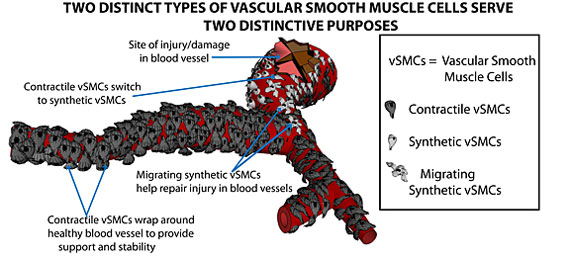| Dec 27, 2012 |
Researchers coax stem cells to diversify
|
|
(Nanowerk News) Growing new blood vessels in the lab is a tough challenge, but a Johns Hopkins engineering team has solved a major stumbling block: how to prod stem cells to become two different types of tissue that are needed to build tiny networks of veins and arteries.
|
|
The team’s solution is detailed in an article appearing in the January 2013 print edition of the journal Cardiovascular Research. The article also was published recently in the journal’s online edition. The work is important because networks of new blood vessels, assembled in the lab for transplanting into patients, could be a boon to people whose circulatory systems have been damaged by heart disease, diabetes and other illnesses.
|
|
“That’s our long-term goal—to give doctors a new tool to treat patients who have problems in the pipelines that carry blood through their bodies,” said Sharon Gerecht, an assistant professor of chemical and biomolecular engineering who led the research team. “Finding out how to steer these stem cells into becoming critical building blocks to make these blood vessel networks is an important step.”
|
 |
|
In the new research paper, the Gerecht team focused on vascular smooth muscle cells, which are found within the walls of blood vessels. Two types have been identified: synthetic smooth muscle cells, which migrate through the surrounding tissue, continue to divide and help support the newly formed blood vessels; and contractile smooth muscles cells, which remain in place, stabilize the growth of new blood vessels and help them maintain proper blood pressure.
|
|
To produce these smooth muscle cells, Gerecht’s lab has been experimenting with both National Institutes of Health-approved human embryonic stem cells and induced pluripotent stem cells. The induced pluripotent stem cells are adult cells that have been genetically reprogrammed to act like embryonic stem cells. Stem cells are used in this research because they possess the potential to transform into specific types of cells needed by particular organs within the body.
|
|
In an earlier study supervised by Gerecht, her team was able to coax stem cells to become a type of tissue that resembled smooth muscle cells but didn’t quite behave properly. In the new experiments, the researchers tried adding various concentrations of growth factor and serum to the previous cells. Growth factor is the “food’ that the cells consume; serum is a liquid component that contains blood cells.
|
|
“When we added more of the growth factor and serum, the stem cells turned into synthetic smooth muscle cells,” Gerecht said. “When we provided a much smaller amount of these materials, they became contractile smooth muscles cells.”
|
|
This ability to control the type of smooth muscle cells formed in the lab could be critical in developing new blood vessel networks, she said. “When we’re building a pipeline to carry blood, you need the contractile cells to provide structure and stability,” she added. “But in working with very small blood vessels, the migrating synthetic cells can be more useful.”
|
|
In cancer, small blood vessels are formed to nourish the growing tumor. The current work could also help researchers understand how blood vessels are stabilized in tumors, which could be useful in the treatment of cancer.
|
|
“We still have a lot more research to do before we can build complete new blood vessel networks in the lab,” Gerecht said, “but our progress in controlling the fate of these stem cells appears to be a big step in the right direction.”
|

